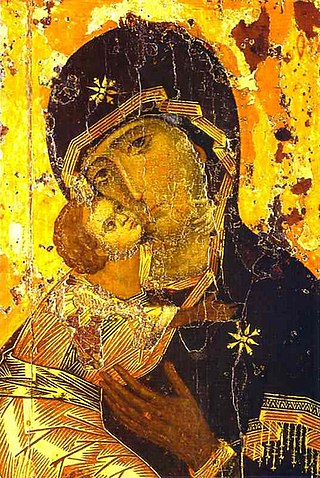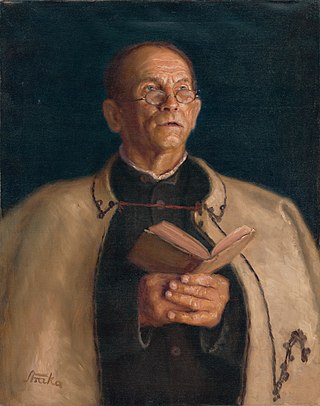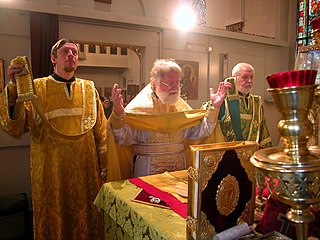Related Research Articles

Medieval music encompasses the sacred and secular music of Western Europe during the Middle Ages, from approximately the 6th to 15th centuries. It is the first and longest major era of Western classical music and is followed by the Renaissance music; the two eras comprise what musicologists generally term as early music, preceding the common practice period. Following the traditional division of the Middle Ages, medieval music can be divided into Early (500–1000), High (1000–1300), and Late (1300–1400) medieval music.
Plainsong or plainchant is a body of chants used in the liturgies of the Western Church. When referring to the term plainsong, it is those sacred pieces that are composed in Latin text. Plainsong was the exclusive form of the Western Christian church music until the ninth century, and the introduction of polyphony.

An antiphon is a short chant in Christian ritual, sung as a refrain. The texts of antiphons are usually taken from the Psalms or Scripture, but may also be freely composed. Their form was favored by St Ambrose and they feature prominently in Ambrosian chant, but they are used widely in Gregorian chant as well. They may be used during Mass, for the Introit, the Offertory or the Communion. They may also be used in the Liturgy of the Hours, typically for Lauds or Vespers.

Gregorian chant is the central tradition of Western plainchant, a form of monophonic, unaccompanied sacred song in Latin of the Roman Catholic Church. Gregorian chant developed mainly in western and central Europe during the 9th and 10th centuries, with later additions and redactions. Although popular legend credits Pope Gregory I with inventing Gregorian chant, scholars believe that it arose from a later Carolingian synthesis of the Old Roman chant and Gallican chant.

The Hilandar Monastery is one of the twenty Eastern Orthodox monasteries in Mount Athos in Greece and the only Serbian Orthodox monastery there.

A neume is the basic element of Western and some Eastern systems of musical notation prior to the invention of five-line staff notation.

Byzantine music originally consisted of the songs and hymns composed for the courtly and religious ceremonial of the Byzantine Empire and continued, after the fall of Constantinople in 1453, in the traditions of the sung Byzantine chant of Eastern Orthodox liturgy. The ecclesiastical forms of Byzantine music are the best known forms today, because different Orthodox traditions still identify with the heritage of Byzantine music, when their cantors sing monodic chant out of the traditional chant books such as the Sticherarion, which in fact consisted of five books, and the Irmologion.

A Theotokion is a hymn to Mary the Theotokos, which is read or chanted during the canonical hours and Divine Liturgy of the Eastern Orthodox and Eastern Catholic churches, as well as in the praises of the Oriental Orthodox churches.

Romanos the Melodist was a Byzantine hymnographer and composer, who is a central early figure in the history of Byzantine music. Called "the Pindar of rhythmic poetry", he flourished during the sixth century, though the earliest manuscripts of his works are dated centuries after this. He was the foremost Kontakion composer of his time.
A sticheron is a hymn of a particular genre sung during the daily evening (Hesperinos/Vespers) and morning (Orthros) offices, and some other services, of the Eastern Orthodox and Byzantine Catholic churches.

Miroslav Gospel is a 362-page Serbian illuminated manuscript Gospel Book on parchment with very rich decorations. It is one of the oldest surviving documents written in the Serbian recension of Church Slavonic. The gospel is considered a masterpiece of illustration and calligraphy.

In Christianity, the cantor, female chantress, sometimes called the precentor or the protopsaltes, is the chief singer, and usually instructor, employed at a church, with responsibilities for the choir and the preparation of the Mass or worship service. The term is also used for a similar task in Reform Judaism and in Ancient Egypt.
The book Octoechos is a liturgical book containing a repertoire of hymns ordered in eight parts according to eight echoi. Originally created in the Monastery of Stoudios during the 9th century as a hymnal complete with musical notation, it is still used in many rites of Eastern Christianity. The book with similar function in the Western Church is the tonary, and both contain the melodic models of an octoechos system; however, while the tonary serves simply for a modal classification, the octoechos is organized as a cycle of eight weeks of services. The word itself can also refer to the repertoire of hymns sung during the celebrations of the Sunday Office.

The Cherubikon is the usual Cherubic Hymn sung at the Great Entrance of the Byzantine liturgy.
Idiomelon —pl. idiomela—is a type of sticheron found in the liturgical books used in the Eastern Orthodox Church, the Eastern Catholic Churches which follow the Byzantine Rite, and many other Orthodox communities like Old Believers. Idiomela are unique compositions, while avtomela or aftomela—sing. automelon, avtomelon or aftomelon —were used to create other hymns by a composition over the avtomelon's melody and following the poetic meter provided by the musical rhythm. The genre composed over these avtomela was characterised as prosomoion or prosomeion.
Medieval Serbian literature or Old Serbian literature refers to the literature written in medieval forms of Serbian language, up to the end of the 15th century, with its traditions extending into the early modern period. During the Middle Ages itinerant scribe monks from the Balkans travelled to Kievan Rus and beyond and their Church Slavonic writings became a common literary language for centuries among all Slavs.
Russian Liturgical Music is the musical tradition of the Russian Orthodox Church. This tradition began with the importation of the Byzantine Empire's religious music when the Kievan Rus' converted to Orthodoxy in 988.

Music of Old Serbia is an album by soloist Dragoslav Pavle Aksentijević with Ensemble Renaissance, released in 1987 on the PGP RTs label. Most of the material from this album is a remaster from Music of the Old Serbia, only this edition is dedicated exclusively to the Medieval Serbian chant and important members of the Serbo-Byzantine school.

Isaiah the Serb was a Serbian Orthodox hieromonk and composer of chants who flourished in the second half of the 15th century. Along with Kir Joakim, Kir Stefan the Serb, Nikola the Serb he faithfully followed Byzantine musical tradition, writing in the late kalophonic style of the 14th and 15th centuries.
Kir Joakim was a Serbian Orthodox monk, choirmaster (domestikos), and the oldest Serbian composer of liturgical melodies. He signed himself "kir Joakim, monk and domestikos of Serbia". Older sources state he lived in the 15th century, while newer sources state that he lived in the 14th century (1360–85). Serbian-American musicologist Miloš Velimirović (1922–2008) made a study on him, Joakim monah i domestik Srbije (1964). The manuscript mentioning him with his titles was dated by Velimirović to before 1453. He lived at the Charsianitos Monastery in Constantinople. The Athens National Library has two Koinonika, a Theotokion, and three Vespers, in Greek, by Kir Joakim. Along with Isaiah the Serb, Kir Stefan the Serb and Nikola the Serb, he is part of medieval Serbian musical heritage, which is also part of Byzantine heritage. One of his works, Kratima Terirem, was included in Dragoslav Aksentijević-Pavle's album Music of Old Serbia (1987).
References
- ↑ Pennington, Anne (January 1973). "Stefan the Serb in Moldavian Manuscripts". The Slavonic and East European Review. 51 (122): 107–112. JSTOR 4206671.
- ↑ Peno, Vesna. "THE STATUS OF CHANTING CODICES IN THE SERBIAN CHANT TRADITION*" (PDF). www.doiserbia.nb.rs. Retrieved 9 January 2025.
- ↑ Milos Lalovic (1941-04-06). "Kir Stefan Srbin Menu". Kirstefansrbin.ca. Retrieved 2013-01-07.
- ↑ "[Project Rastko] THE HISTORY OF SERBIAN CULTURE - Roksanda Pejovic: Medieval music". Rastko.rs. Retrieved 2013-01-07.